John Trumbull
| John Trumbull | |
|---|---|
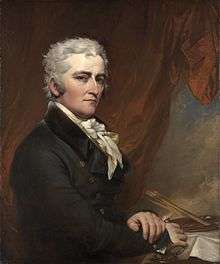 Self-portrait, c. 1802 | |
| Born |
June 6, 1756 Lebanon, Colony of Connecticut, British America |
| Died |
November 10, 1843 (aged 87) New York City, U.S. |
| Nationality | American |
| Education | with Benjamin West |
| Known for | Painting |
| Notable work | Declaration of Independence (painted 1817–1819) |
John Trumbull (/ˈtrʌmbəl/; June 6, 1756 – November 10, 1843) was an American artist during the period of the American Revolutionary War and was notable for his historical paintings. He has been called The Painter of the Revolution.[1]
Trumbull's Declaration of Independence (1817), one of his four paintings which hang in the United States Capitol Rotunda, was used on the reverse of the commemorative bicentennial two-dollar bill.
Early life
Trumbull was born in Lebanon, Connecticut, in 1756, to Jonathan Trumbull and his wife Faith (née Robinson) Trumbull. His father served as Governor of Connecticut from 1769 to 1784. Both sides of his family were descended from early Puritan settlers in the state.
He had two older brothers, Joseph Trumbull, the first commissary general of the Continental Army in the Revolutionary War, and Jonathan Trumbull Jr., who would become the second Speaker of the House of the United States.
The young Trumbull entered the 1771 junior class at Harvard College at age fifteen and graduated in 1773. Due to a childhood accident, Trumbull lost use of one eye, which may have influenced his detailed painting style.[2]
Revolutionary War
As a soldier in the American Revolutionary War, Trumbull rendered a particular service at Boston by sketching plans of the British works. He witnessed the Battle of Bunker Hill. He was appointed second personal aide to General George Washington, and in June 1776, deputy adjutant-general to General Horatio Gates.[3] He resigned from the army in 1777 after a dispute over the dating of his officer commission.
In 1780, with funds depleted, Trumbull turned to art as a profession. He traveled to London, where upon introduction from Benjamin Franklin, Trumbull studied under Benjamin West. At West's suggestion, Trumbull painted small pictures of the War of Independence and miniature portraits. He painted about 250 in his lifetime.[4]
On September 23, 1780, British agent Major John André was captured by Continental troops in North America; he was hanged as a spy on October 2, 1780. After news reached Great Britain, outrage flared and Trumbull was arrested, as having been an officer in the Continental Army of similar rank to André.[3] He was imprisoned for seven months in London's Tothill Fields Bridewell.[5][6]
After being released, Trumbull returned to the United States in a voyage that lasted six months, ending late January 1782. He then joined his brother David in supplying the army stationed at New Windsor, New York during the winter of 1782–83.[7][8]
Postwar years
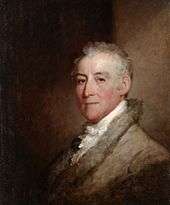
In 1784, following the British recognition of the United States' independence, Trumbull returned to London for painting study under West. While working in his studio, Trumbull painted Battle of Bunker Hill and Death of General Montgomery in the Attack on Quebec. Both works are now in the Yale University Art Gallery.
In 1785 Trumbull went to Paris, where he made portrait sketches of French officers for the Surrender of Lord Cornwallis. With the assistance of Thomas Jefferson, serving there as the US minister, Trumbull began Declaration of Independence.[3] Over the next 5 years Trumbull painted small portraits of signers, which he would later use to piece together the larger painting. If the signer was deceased, a previous portrait would be copied, as was the case with Arthur Middleton, whose head position stands out in the painting. While visiting with each signer or their family, Trumbull, always looking for funding, used the occasion to sell subscriptions to engravings that would be produced from his paintings of the American Revolution.[4]
While in Paris, Trumbull is credited with having introduced Jefferson to the Italian painter Maria Cosway; they became lifelong intimate friends. Trumbull's painting of Jefferson, commissioned by Cosway, became widely known due to a later engraving of it by Asher Brown Durand, which was reproduced.
Trumbull's Declaration of Independence painting was purchased by the United States Congress, along with his Surrender of General Burgoyne, Surrender of Lord Cornwallis, and General George Washington Resigning His Commission, all related to the Revolution. All now hang in rotunda of the United States Capitol. Congress reportedly authorized only funds sufficient to purchase these four paintings.
Trumbull completed several other paintings related to the Revolution:
- Death of General Warren at the Battle of Bunker's Hill (one version is held by the Boston Museum of Fine Arts);
- Death of General Montgomery at Quebec;
- Capture of the Hessians at Trenton;
- Death of General Mercer at the Battle of Princeton; and
- The Sortie Made by the Garrison of Gibraltar, 1789. This was once owned by the Boston Athenaeum and is now held by the Metropolitan Museum of Art in New York City.[3]
Middle years
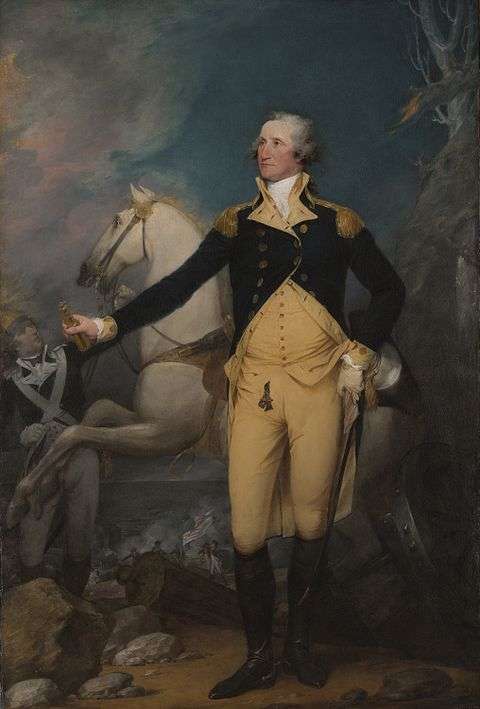
Trumbull encountered hard times in which he was failing to sell his paintings individually; in 1831 he sold a series of 28 paintings and 60 miniature portraits to Yale University for an annuity of $1,000. After many years of trying to create income from his painting, he had finally found a way to sustain himself from his art.[4] This is by far the largest single collection of his works. The collection was originally housed in a neoclassical art gallery designed by Trumbull on Yale's Old Campus, along with portraits by other artists.[9]
His portraits also include full lengths of General Washington (1790) and George Clinton (1791), now held in New York City Hall.[3] New York also bought his full-length paintings of Alexander Hamilton (1805, the source of the face on the $10 bill[10]) and John Jay. In 1791 Trumbull was elected a Fellow of the American Academy of Arts and Sciences.[11]
He painted portraits of John Adams (1797), Jonathan Trumbull, and Rufus King (1800); Timothy Dwight and Stephen Van Rensselaer (both at Yale), Alexander Hamilton (one in the Metropolitan Museum of Art and one in the Boston Museum of Fine Arts, both taken from Ceracchi's bust), a self-portrait (1833), a full-length of Washington, held at Charleston, South Carolina; a full-length of Washington in uniform, General George Washington at Trenton, (1792, at Yale); and portraits of President and Mrs. Washington (1794), in the National Museum of American History.[3]
Trumbull was painted by Gilbert Stuart and many others.
In 1794 Trumbull acted as secretary to John Jay in London during the negotiation of the treaty with Great Britain, which largely settled the boundary with Canada and began cotton export. In 1796 he was appointed by the commissioners sent by the two countries as the fifth member of a commission charged with carrying out the seventh article of the Jay Treaty,[3] which mediated claims by American and British merchants and the opposing government stemming from actions which occurred during the war. Shortly after the end of Trumbull's service on this commission, he traveled to Stuttgart to pick up the completed engraving of the Battle of Bunker's Hill. On the return trip he passed through Paris and carried the first dispatch from the XYZ Affair out of France.[12]
Later years
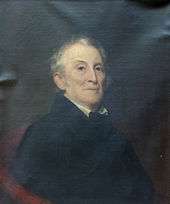
Trumbull was appointed president of the American Academy of the Fine Arts in New York City, serving for twenty years, from 1816 to 1836.[13] Emphasizing classical traditions, Trumbull did not get along with the students. At the same time, his painting skills declined. In 1825 many of the students withdrew, founding the National Academy of Design.[14] Unable to accommodate to changing tastes, the American Academy later closed in 1839 after a second fire destroyed its collections.
Trumbull wrote his autobiography, which he published in 1841. He died in New York City at the age of 87 on November 10, 1843.
Legacy and honors
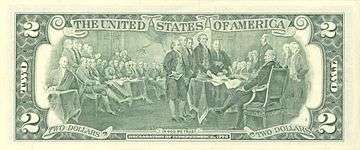
John Trumbull's Declaration of Independence
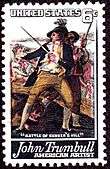
- Trumbull was originally interred (along with his wife) beneath the Art Gallery at Yale University, which he had designed. In 1867, the collection of his works were moved to the newly built Street Hall. His and his wife's remains were reinterred on those grounds.[15] The Trumbull Gallery was later razed.
- 1965, the John Trumbull Birthplace in Lebanon, Connecticut, was declared a National Historic Landmark.
- 1968, a John Trumbull commemorative postage stamp was printed.
In popular culture
Trumbull's painting The Declaration of Independence is mentioned in the opening track of The Hamilton Mixtape recorded by The Roots based on work by Lin-Manuel Miranda called "No John Trumbull – Intro."[16] The song plays on the fact that the Founding Fathers look as if standing patiently in a line, saying that "the reality is messier and richer."[17]
Paintings
- The Death of General Warren at the Battle of Bunker's Hill, June 17, 1775
- The Death of General Montgomery in the Attack on Quebec
- Declaration of Independence
- The Capture of the Hessians at Trenton, December 26, 1776
- The Death of General Mercer at the Battle of Princeton, January 3, 1777
- The Surrender of General Burgoyne at Saratoga
- The Surrender of Cornwallis at Yorktown
- General George Washington Resigning His Commission
- Portraits of George Washington and John Adams
- The Death of Aemilius Paullus at the Battle of Cannae
- The Sortie Made by the Garrison of Gibraltar
- Self-portrait
- Portrait of Josiah Bartlett
- Jonathan Trumbull, Jr. (1740–1809) with Mrs. Trumbull (Eunice Backus) (1749–1826) and Faith Trumbull (1769–1846)
Gallery
Historic events
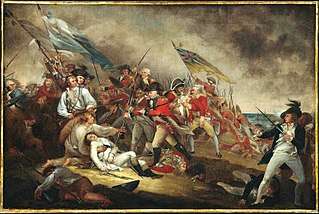 The Death of General Warren at the Battle of Bunker Hill (event 1775, painted 1786)
The Death of General Warren at the Battle of Bunker Hill (event 1775, painted 1786)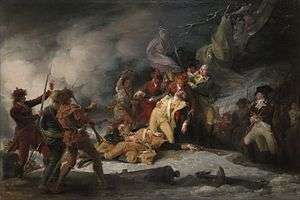 The Death of General Montgomery in the Attack on Quebec, December 31, 1775 (event 1775, painted 1786)
The Death of General Montgomery in the Attack on Quebec, December 31, 1775 (event 1775, painted 1786)%2C_by_John_Trumbull.jpg) The Declaration of Independence (event 1776, painted 1819)
The Declaration of Independence (event 1776, painted 1819) The Capture of the Hessians at Trenton, December 26, 1776 (event 1776, painted 1786–1828)
The Capture of the Hessians at Trenton, December 26, 1776 (event 1776, painted 1786–1828)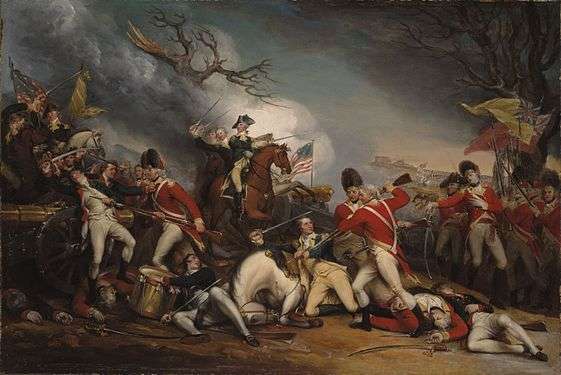 The Death of General Mercer at the Battle of Princeton, January 3, 1777 (event 1777, c. 1787–c. 1831)
The Death of General Mercer at the Battle of Princeton, January 3, 1777 (event 1777, c. 1787–c. 1831) Surrender of General Burgoyne (event 1777, painted 1821)
Surrender of General Burgoyne (event 1777, painted 1821)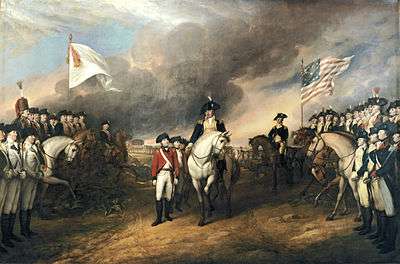 Surrender of Lord Cornwallis (event 1781, painted 1820)
Surrender of Lord Cornwallis (event 1781, painted 1820)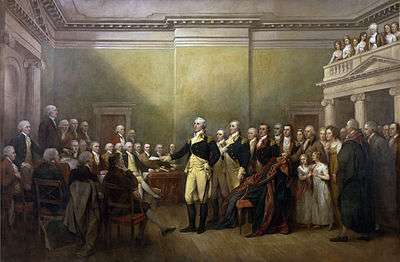 General George Washington Resigning His Commission (event 1783, painted 1824)
General George Washington Resigning His Commission (event 1783, painted 1824)
Portraits
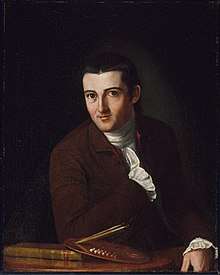 Self-portrait, 1777
Self-portrait, 1777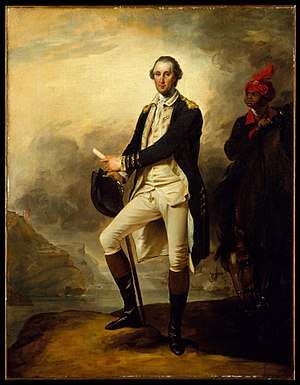 George Washington, 1780
George Washington, 1780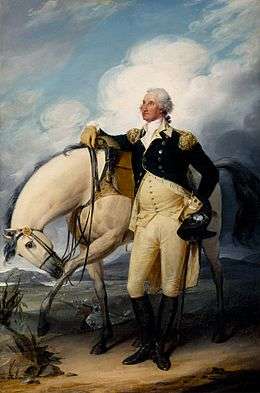

 George Clinton, 1791
George Clinton, 1791 Lady in White
Lady in White Self-portrait, c. 1802
Self-portrait, c. 1802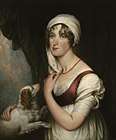 Mrs Sarah Trumbull with a spaniel 1802
Mrs Sarah Trumbull with a spaniel 1802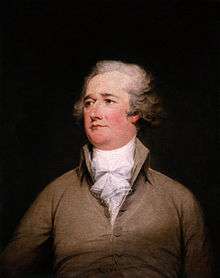 Alexander Hamilton, 1792
Alexander Hamilton, 1792 Alexander Hamilton, 1792
Alexander Hamilton, 1792 Alexander Hamilton, 1805
Alexander Hamilton, 1805 Alexander Hamilton, 1832
Alexander Hamilton, 1832
Miniature portraits/sketches
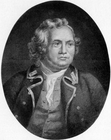 Israel Putnam, 1790
Israel Putnam, 1790 Richard Butler (general), 1790
Richard Butler (general), 1790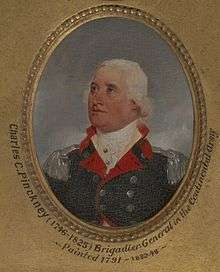
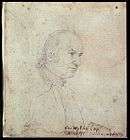 George Wythe, 1791
George Wythe, 1791
Notes
- ↑ Johnston, Elizabeth Bryant (1882). "John Trumbull". Original Portraits of Washington, including Statues, Monuments and Medals. p. 66. OCLC 3303313.
- ↑ "Gentleman John Trumbull". Time Magazine. 1956-10-29. Retrieved 2008-02-17.
- 1 2 3 4 5 6 7

- 1 2 3 Trumbull (1841), pp. 288–94.
- ↑ Jaffe (1975), p. 50.
- ↑ Heleniak, Kathryn Moore. "Benjamin West and John Trumbull". Fordham University. Archived from the original on 2016-03-20. Retrieved 2017-11-19.
- ↑ Jaffe (1975), pp. 53–54.
- ↑ Trumbull (1841), p. 88.
- ↑ "Yale University Art Gallery: Architecture". Trumbull Gallery (1832)
- ↑ Dunlap, David W. (2006-12-06). "In New York, Taking Years Off the Old, Famous Faces Adorning City Hall". The New York Times. Retrieved 2007-01-07.
- ↑ "Book of Members, 1780–2010: Chapter T" (PDF). American Academy of Arts and Sciences. Retrieved August 7, 2014.
- ↑ Jaffe (1975), pp. 177–82.
- ↑ Jaffe (1975), pp. 264–75.
- ↑ Dunlap, William (1918). A History of the Rise and Progress of the Arts of Design in the United States (Vol 3). C. E. Goodspeed & Co. pp. 52–57. Retrieved 2008-02-17.
- ↑ Trumbull Gallery at Yale Archived 2007-03-05 at the Wayback Machine.
- ↑ "Usher, Sia, Jimmy Fallon Lead 'Hamilton Mixtape' Track List". Rolling Stone. Retrieved 2017-04-29.
- ↑ Lin-Manuel Miranda (Ft. Christopher Jackson, Leslie Odom Jr. & Okieriete Onaodowan) – No John Trumbull, retrieved 2017-04-29
References
- Trumbull, John (1841). Autobiography, Reminiscences and Letters of John Trumbull from 1756 to 1841. New York: Wiley and Putnam.
- Weir, J. F. (1901). John Trumbull, A Brief Sketch of His Life, to which is added a Catalogue of his Works. New York: C. Scribner's sons. Retrieved 2008-02-16.
- Durand, John (1881). "John Trumbull". American Art Review. Boston. ii (2): 181–191.
- Murray, P. & L. (1996). Dictionary of Art and Artists. Penguin Books. ISBN 0-14-051300-0.
- Cooper, Helen A. (1983). John Trumbull: The Hand and Spirit of a Painter. New Haven, CT: Yale University Press. ISBN 978-0894670244.
- Jaffe, Irma B. (1975). John Trumbull, Patriot-Artist of the American Revolution. Boston, MA: New York Graphic Society. ISBN 9780821204597.
- Sizer, Theodore (1950). The Works of Colonel John Trumbull, Artist of the American Revolution. Yale University Press.
External links
| Wikimedia Commons has media related to John Trumbull. |
- The Winterthur Library Overview of an archival collection on John Trumbull.
- Union List of Artist Names, Getty Vocabularies. ULAN Full Record Display for John Trumbull. Getty Vocabulary Program, Getty Research Institute. Los Angeles, California.
- Art and the empire city: New York, 1825–1861, an exhibition catalog from The Metropolitan Museum of Art (fully available online as PDF), which contains material on Trumbull (see index)
- Guide to the John Trumbull Papers, 1775–1842
- John Trumbull at Find a Grave